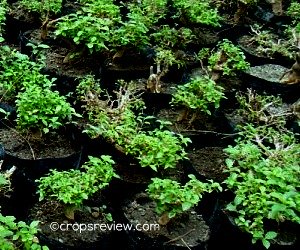The molave tree (Vitex parviflora Juss.) is a plant belonging to the family Verbenaceae.
It is a close relative of the five-leaved chaste tree or lagundi (Vitex negundo).
Also called molawin and tugas, it is a medium- to large-sized, drought-tolerant, hardwood tree which is indigenous to the Philippines and other Asian countries. It has multiple uses.
In Sarangani, Philippines, these trees naturally grow on limestone, sinking their roots into crevices.
Two types are indigenous in the province. One is locally called tugas babae (“babae” is Filipino word for woman). The other type is called tugas lanhan (“lanhan” means oily).
Tugas babae has longer leaves with more or less straight trunk while tugas lanhan has smaller leaves with twisted trunk and branches.
The former favors growing in the northern parts of the province while the latter dominates in the south.
However, with improved access and expansion of development towards the south of General Santos City, thousands of naturally miniaturized tugas lanhan have since been uprooted for bonsai.

In general, there are two classifications of propagation methods: sexual and asexual.
This tree can be propagated following sexual or asexual method.
In general, sexual propagation is with the use of seed while asexual propagation is with the use of vegetative plant parts.
The practice of plant collection also showed the applicability of the propagation method called bareroot transplanting which is recommended for coffee and forest tree wildlings.
This method was also proven effective for mango seedlings and other fruit crops but we failed in jackfruit.
The seedling, or even one having trunk as thick as 50 cm at the base, is simply pried loose from the soil and immediately transported to the nursery.
As a rule, the bareroot tree should be immediately planted.
But experiences by bonsai collectors proved that planting can be delayed for a few days, provided that the tree is soaked in water to prevent dehydration.
The potted tree is kept under partial shade in plastic tent (the technique is also called “kulob” and “bukot”).
Another propagation method which applies to this tree is with the use of stem cuttings.
This has been practiced since year 2000 by some ornamental growers and further verified experimentally at the Mindanao State University, General Santos City.
Stem cuttings 7.5-15 cm long (short for thin cuttings) with thickness up to 2 cm can be used.
These can be obtained from naturally growing dwarf plants. Rooting hormone is not essential.
Stem cutting has long been used in propagating many woody plants including coffee, cacao, kalamansi and ornamental crops.
The technique also applies to bottle gourd, squash, sambong, tomato and eggplant.
These propagation methods have potential application in the commercialized production of molave seedlings for the purpose of agroforestry, reforestation, urban greening, landscaping and other uses.
Although molave grows from seeds, these are not readily available due to the seasonal flowering habit of this tree.
Moreover, mature trees are hard to find.
I Molave Botany and Growth I Tugas Lanhan vs Tugas Babae I Uses and Prospects I Alternative Propagation I Molave Bonsai I
